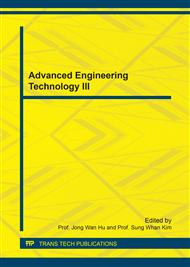p.429
p.434
p.442
p.450
p.457
p.463
p.468
p.474
p.480
Fault Detection of Actuators of Robot Manipulator by Vision System
Abstract:
This paper considers synthesis method of fault detection system for actuators of robot manipulators based on using of signals fusion from stereo camera, angles sensors of joints and desired values of joint variables. The vision system is used for determining the position of three markers rigidly connected with working tool in the coordinate system associated with the manipulator. The advantage of proposed fault detection system is the simplicity of implementation and precision of detection of typical faults without knowledge about non-linear dynamic of robot and actuators. The results of mathematical simulation on the example of the PUMA-type manipulator using its kinematic model, position and orientation data of markers placed on working tool of manipulator, obtained from vision system fully confirm the efficiency of the proposed fault detection system.
Info:
Periodical:
Pages:
457-462
Citation:
Online since:
June 2017
Authors:
Keywords:
Price:
Сopyright:
© 2017 Trans Tech Publications Ltd. All Rights Reserved
Share:
Citation:


